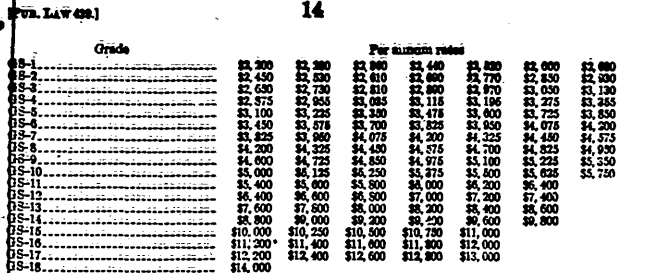General Schedule Pay Scale: Past, Present and Future
General Schedule History
The General Schedule (GS) Pay Scale was created by the Classification Act of 1923 and refined in the Classification Act of 1949. Today, the GS Pay Scale is codified in Chapter 53, Title 5 U.S.C. §§ 5331-5338. This law lays out the structure of the GS pay scale and appoints the Office of Personnel Management (OPM) to administer most of the details. The pay scale was originally created with the purpose of keeping federal salaries in line with equivalent private sector jobs. Over time, GS pay scale has evolved into what we have today.
The General Schedule is a schedule of annual rates of basic pay, consisting of 15 grades, designated “GS–1” through “GS–15”, consecutively, with 10 rates of pay for each such grade.
Excerpt from Title 5 U.S.C. §§ 5332
The original 1949 system had 18 grades and up to 10 steps depending upon grade. However, the locality pay adjustments did not come until much later. The GS Pay Scale officially went into effect at October 28, 1949. The highest possible pay rate was only $14,000.
 Image of the original General Schedule Pay Table published in the Classification Act of 1949
Image of the original General Schedule Pay Table published in the Classification Act of 1949
In the early 1990's, the pay gap between public and private sector jobs was increasing. To remedy this pay gap, congress passed an update to Title 5 U.S.C. requiring "each locality determined to have a pay disparity greater than 5 percent".
More: What are Grade and Step?
In January 1994, locality adjustments first went into effect. At the time there were just 29 locality areas. The locality adjustments were between 3% to 6%. OPM still maintains a record of the old pay rates on line. View the 1994 GS pay rates
General Schedule Pay
The General Schedule Pay Scale is the most widely used pay scale for white-collar federal civilian employees. There are over 1.5 million federal employees on the GS scale. Positions range from administrative jobs to managerial and technical positions.
Other alternative pay scales include: Federal Wage Grade Schedule (FWS) which is used for blue-collar, hourly positions; Senior Executive Service (SES) which is used for high level executive positions above the highest GS positions; Foreign Service Schedule (FS) which is used for Foreign Service members; and at least 12 alternative or experimental pay schedules.
Thirteen new locality areas were added in 2016. There are now 47 locality areas -- regions across the country where employees are paid more to compensate for higher cost of living. The last time locality areas were changed was in 2006.
Future of the General Pay Schedule
The General Schedule has been used for over 90 years. The system has evolved greatly to keep up with the times. However, the GS system is not perfect.
There is a significant pay gap between civil service positions and their private sector equivalent. One of the main objectives of the GS system was the reduce this pay gap. The GS schedule does do a good job of ensuring equal pay for equal work by reducing pay gaps between men, women, and minorities.
Others have complained that the GS scale does not provide merit based incentives. People in favor of overhauling the GS system argue that there is little motivation when employees are paid the same regardless of performance. The Federal Employee Union, American Federation of Government Employees (AFGE), opposes changes to the GS pay schedule arguing it ensures equal pay for equal work.
Several "experimental" pay scales have been created to test the idea of merit based pay. The Pay Band system is one such experimental, merit-based pay system. In the Pay Band system, there are 6 "bands." Each band maps to a range of GS pay grades with a large pay range. Based on performance, your pay will fall somewhere within your band's pay range.
Some experimental pay scales are still being used. However, the General Schedule system is still by far largest pay system in use and is not going anywhere in the foreseeable future.
Related Articles
Article Tags
- General Schedule
- History